Results 9,601 to 9,610 of 12096
Thread: Anandtech News
-
06-12-19, 12:06 PM #9601
Anandtech: TeamGroup Cardea Zero PCIe 4.0 x4 SSD: Up to 1 TB
Also on display at the TeamGroup booth was its T-Force Cardea Zero PCIe 4.0 x4 M.2 which uses the Phison PS5016-E16 controller which we saw frequently throughout Computex this year. The T-Force Cardea Zero PCIe 4.0 x4 SSD will be available in 256 GB, 512 GB, and 1 TB capacities and conforms to the M.2 2280 form factor.

As with other other E16 SSD vendors, we are expecting stock to come to market through the year. What makes TeamGroup's version different to others is that the company stated to us that there will be a 256 GB model. At present, none of the other E16 vendors have committed to an SSD of this side, instead all saying that a 500/512GB model will be the first to come to the market.
Want to keep up to date with all of our Computex 2019 Coverage? 
Laptops
Hardware
ChipsFollow AnandTech's breaking news here!
More...
-
06-12-19, 02:27 PM #9602
Anandtech: TeamGroup T-Force Xcalibur ARGB DDR4-4000 at Computex
At Computex 2019, TeamGroup unveiled a couple of new products aimed at users looking for high-end components. One of these was its refreshed T-Force Xcalibur DDR4 memory now with addressable ARGB LEDs.
During CES 2019, TeamGroup announced a set of ASRock Phantom Gaming branded Xcalibur RGB modules, fast forward to Computex 2019, TeamGroup had its new T-Force Xcalibur ARGB on display with the new ARGB heatsinks modelled over a high-end kit of DDR4-4000 Samsung B-Die based memory kit.
The T-Force Xcalibur ARGB memory is very similar in design to the previous special edition Xcalibur RGB modules, but with new addressable RGB LEDs which seems to be the new market trend for gaming-focused brands. Each heatsink has a black aluminium finish with the Xcalibur and T-Force logos, with the 120 degrees angled lighting coming from the light bar at the top of the module which includes an Aztec inspired patterning.
While TeamGroup only had a DDR4-4000 16 GB (2 x 8 GB) kit on display, it remained silent on which frequencies and capacity configurations it would be available to end users in. It will likely cover the same kits the T-Force Xcalibur RGB are available in including DDR4-3600 and DDR4-4000.
Want to keep up to date with all of our Computex 2019 Coverage? 
Laptops
Hardware
ChipsFollow AnandTech's breaking news here!
More...
-
06-12-19, 06:28 PM #9603
Anandtech: Lenovo Unveils ThinkPad P1 Gen 2: New 15.6-Inch Carbon Fiber Chassis
Lenovo has introduced its second-generation ultra-thin ThinkPad P1 mobile workstation. The new 15.6-inch laptop promises to be faster than its predecessor launched last year because of the new CPU and GPU, yet it will use a new carbon fiber chassis that is actually thinner and slightly lighter.
Lenovo’s ThinkPad P1 Gen 2 is based on Intel’s 9th Gen Core or Xeon processor that is paired with up to 64 GB DDR4 memory with or without ECC (up to two SO-DIMMs), NVIDIA’s Quadro T1000 or Quadro T2000 graphics on higher-end SKUs, and up to two M.2 SSDs (featuring up to 4 TB of NAND in total) with a PCIe 3.0 x4 interface and working in RAID 0 or RAID 1 mode.
Just like in case of the first-generation ThinkPad P1, the new 15.6-inch ultra-thin workstation will be offered with several types of displays. The most advanced models will come with an Ultra-HD OLED display supporting touch and Dolby Vision HDR, whereas regular SKUs will be equipped with Full-HD IPS LCDs.
As for connectivity, the Lenovo ThinkPad P1 has Intel’s AX200 Wi-Fi 6 solution featuring up to 2.4 Gbps throughput over 160 MHz channels. As for hardware interfaces, the ThinkPad P1 Gen 2 is equipped with two Thunderbolt 3 ports, two USB 3.1 Gen 1 Type-A connectors, a mini GbE port (requires a dongle), an HDMI 2.0 output, an optional smart card reader, a 4-in-1 card reader, a webcam with IR and ThinkShutter, a fingerprint scanner, and a 3.5-mm audio port.
The ThinkPad P1 Gen 2 comes in a new carbon fiber chassis that is 17.2 mm thick, down from 18.4 mm on the first-generation model. Traditionally for ThinkPads, the chassis is rugged enough to take bumps of everyday use by a road warrior and can withstand cold, heat, humid, dust, fungus, shocks and other harsh environments. Despite being slightly thinner than predecessors, the ThinkPad P1 Gen 2 still has an 80 Wh battery and weighs around 1.7 kilograms.
The ThinkPad P1 Gen 2 will ship at the end of June, starting at $1,949.
Related Reading:Lenovo's ThinkPad P1 Gen 2 ThinkPad P1 Gen 2 FHD ThinkPad P1 Gen 2 4K UHD Display Type IPS OLED Resolution 1920×1080 3840×2160 Brightness 300/500 cd/m² 400 cd/m² Color Gamut 72% NTSC ? Touch No Yes HDR No Dolby Vision HDR CPU Intel's 9th Generation Core i7/i9 or Xeon Graphics Integrated UHD Graphics 620 (24 EUs) Discrete NVIDIA Quadro T1000 or T2000 RAM up to 64 GB DDR4 Storage up to 4 TB PCIe SSDs with RAID 0/RAID 1 Wi-Fi Intel Wireless AX200 2.4 Gbps Bluetooth Bluetooth 5 Thunderbolt 2 × USB Type-C TB3 portsUSB 2 × USB 3.1 Gen 1 Type-AHDMI HDMI 2.0 GbE Native, with a dongle Fingerprint Sensor Yes Webcam HD camera with ThinkShutter
HD camera with IR for Windows Hello and ThinkShutterOther I/O Microphone, stereo speakers, TRRS audio jack (with Dolby Atmos enhancements for appropriate headphones), joystick, trackpad, card reader, etc. Battery 80 Wh Dimensions Thickness 17.2 mm Width 361.8 mm Depth 245.7 mm Weight 1.7 kilograms | 3.76 lbs Operating System Windows 10 Pro
- Lenovo Launches Ultra-Thin ThinkPad P1: X1 Carbon Meets Workstation
- Lenovo's Halo: The ThinkPad X1 Extreme Announced
- Lenovo Unveils ThinkPad X1 Extreme Gen 2: New CPU, GPU, OLED Display Option
- Lenovo ThinkStation P720 & P920 now with Cascade Lake & Quadro RTX 8000
- Lenovo at CES 2019: 7th Gen ThinkPad X1 Carbon Gets Thinner
Source: Lenovo
More...
-
06-13-19, 08:57 AM #9604
Anandtech: Corsair Unveils Nightsword RGB and M55 RGB Pro Gaming Mice
Corsair, the peripheral, cooling, and jack of all trades powerhouse has unveiled two new gaming mice, the Nightsword RGB, and M55 RGB Pro Gaming mouse. The Corsair Nightsword RGB is weight tunable with a Pixart PMW3391 18,000 DPI optical sensor, while the Corsair M55 RGB Pro uses an ambidextrous design with a 12,400 DPI optical sensor, and uses Omron switches rated at 50 million clicks.
Gallery: Corsair Nightsword RGB Mouse Gallery





Corsairs new premium Nightsword RGB features ten programmable buttons with the option to select up to 120 different weight combinations. The Nightsword RGB has six different weight mounting locations with two sets of weights to use. Users can customize the weight between 119 g and 141 g. On the frame is four dynamic RGB LED lighting zones which can be customized using the Corsair iCUE software. Inside the mouse is a Pixart PMW3391 optical sensor which offers up to 18,000 DPI and allows users to adjust in 1 DPI increments offering total control over the sensitivity.
Gallery: Corsair M55 RGB Pro Mouse Gallery_thumb.jpg)





The Corsair M55 RGB Pro it features an ambidextrous design with a predefined weight of 86 g. A total of eight customizable buttons, and combined with the Corsair iCUE software, the M55 RGB Pro has dynamic RGB backlighting. With premium Japanese Omron switches, the M55 RGB Pro is tested with a durability of up to 50 million mouse clicks, and also uses a simple plug and play setup for gamers looking for a quick and easy option to game on the go.
The Corsair Nightsword RGB comes with a premium MSRP of $80, while the M55 RGB Pro is offered at a more reasonable price of just $40, with the option to select black or white. Availability on both Corsairs new mice is currently unknown, but it is likely that both the Nightsword RGB and M55 Pro RGB will be launched later this month.
Want to keep up to date with all of our Computex 2019 Coverage? 
Laptops
Hardware
ChipsFollow AnandTech's breaking news here!
More...
-
06-13-19, 11:28 AM #9605
Anandtech: Realtek Demonstrates RTD2173 DisplayPort 1.4 to HDMI 2.1 Converter
Realtek is working on a chip that will convert DisplayPort 1.4 signals to HDMI 2.1 signals. The RTD2173 converter will enable makers of notebooks, motherboards, docks, and other applications to build devices supporting next-gen HDMI output using current-generation graphics processors that only support DisplayPort 1.4 outputs. Meanwhile, such products will have certain peculiarities.
A number of modern high-end televisions featuring an 8K resolution are outfitted with HDMI ports that are technically ready to receive HDMI 2.1 signals, but are not marketed as HDMI 2.1 because they have not been certified by the HDMI Forum. Once the certification program for HDMI 2.1 is available, producers of Ultra-HD TVs can validate their devices and issue appropriate firmware updates to formally add HDMI 2.1 support. Makers of HDMI cables will release their Ultra High Speed HDMI (48G) cables around the same time.
Meanwhile, at present there are no GPUs that support HDMI 2.1 connection, and even Intel’s 10th Gen Core processors codenamed Ice Lake never mention support for this standard. Therefore, to connect an 8K TV featuring an HDMI 2.1 interface to PCs (or other applications featuring a DP 1.4) special converters or adapters will be needed. This is where Realtek’s RTD2173 chips comes into play.
The RTD2173 chip converts DisplayPort 1.4 signals to HDMI 2.1 signals to enable up to 3840×2160@240 Hz or 7680×4320@60 Hz resolution using a single cable. Keep in mind that the maximum bandwidth supported by a DP1.4 interconnection using the HBR3 data rates is 32.4 Gbps, which is enough for 8Kp60 when Display Stream Compression 1.2 is used. Meanwhile, the maximum bandwidth of HDMI 2.1 is 48 Gbps and it does not need to use DSC 1.2 for 8Kp60.
Realtek’s RTD2173 converter has been implemented in silicon and once it receives certification from the HDMI Forum, it can be used by makers of PCs, dongles, docks, adapters, cables, and other products. Expects devices with HDMI 2.1 output to be available in the coming quarters.
Want to keep up to date with all of our Computex 2019 Coverage? 
Laptops
Hardware
ChipsFollow AnandTech's breaking news here!
More...
-
06-13-19, 11:28 AM #9606
Anandtech: HDMI Forum: Certification Program for Ultra High Speed HDMI 48G Incoming
While the first HDMI 2.1 48G-branded cables were announced back in late 2018, they were not formally certified by the HDMI Forum for one reason: the certification program for HDMI 2.1 was not ready then and it is still not ready now. Yet, numerous developers of cables are already demonstrating prototypes of their HDMI 48G products that are marked as Ultra High Speed HDMI. Furthermore, makers of televisions are prepping the first Ultra-HD TVs that use HDMI 2.1.
UHS HDMI Certification Program
HDMI 2.1 48G cables use four data lanes operating at 12 Gbps each for an aggregate bandwidth of 48 Gbps, up from 18 Gbps today, yet retaining backwards compatibility with existing equipment. The additional bandwidth HDMI 2.1 offers enables it to support new Ultra-HD resolutions and refresh rates including, including 4Kp120, 8Kp100/120, 10Kp100/120, and upcoming color spaces, such as BT.2020 (Rec. 2020) with 10, 12, or even more advanced with 16 bits per color component. Actually, high resolutions and bit depths eat up 48 Gbps of bandwidth quickly, so for anything higher than 8Kp60 with 4:2:0 chroma sub sampling and 10-bit color, VESA’s DSC 1.2a link compression technology is used.
Since HDMI 2.1 48G cables as well as sources and sinks are physically different from existing HDMI 1.4/2.0 cables, makers of appropriate products have to adopt new manufacturing methods, whereas HDMI Forum has to introduce a new certification program that includes various compliance tests that ensure that interconnections work fine at high data rates and support all the features. Makers of cables are typically experienced enough to build HDMI 2.1 48G products, HDMI Forum admits. Since however there is no HDMI 2.1 48G certification program, they are not advised to sell products marked as Ultra High Speed HDMI Cables.
The HDMI Forum plans to make its UHS HDMI interconnection certification program available in the next several months, so expect ‘official’ HDMI 48G copper and optical cables to become available in the foreseeable future. Furthermore, once compliance tests are ready, makers of TVs will be able to mark their TVs as HDMI 2.1 compatible.
In addition to new resolutions, refresh rates, and HDR bit depths, HDMI 2.1 offers numerous new features, including Variable Refresh Rate (VRR), Quick Media Switching (QMS), Quick Frame Transport (QFT), and eARC. These capabilities do not need 48G cables for content with up to 4Kp60 resolution and 4:4:4 chroma subsampling. But, a combination of 4Kp120/4:4:4 and VRR will require UHS HDMI cables. Meanwhile, once the new cables are available, the industry is going to need 4Kp120 or 8Kp60 sources and content.
2020 Summer Olympics & China to Drive 8K Adoption
By now, numerous leading makers of televisions have introduced their Ultra-HD TVs with an 8K resolution. Meanwhile, since 8K content is barely available, such devices are hardly popular among the end user. This is going to change next year when Tokyo 2020 summer Olympics will be filmed and broadcast in this resolution. Furthermore, as China has a government plan to transit to 4K and 8K broadcasting in the next few years, Ultra-HD content will get another boost.
Sports fans will naturally appreciate Tokyo 2020 and Beijing 2022 Olympics filmed in 8K, people from the HDMI Forum believe, which will boost adoption of the latest televisions not only in Japan and China, but everywhere across the world. Another major driver for Ultra-HD adoption will be the plan of China’s Ministry of Industry and Information Technology, National Radio and Television Administration, and the China Media Group (CMG) to develop Ultra-HD industry in 2019 – 2022. The plan looks very complex as it includes everything from content creation to broadcasting to production of equipment for creators and users.
Related Reading:
- HDMI Forum Demonstrates HDMI 2.1 VRR Capabilities on Samsung TV
- HDMI 2.1 Nears Release: Club3D Announces Ultra-High Speed 48G Cable
- HDMI 2.1 Specification Released: Variable Refresh, Dynamic HDR, & More In 2018
Want to keep up to date with all of our Computex 2019 Coverage? 
Laptops
Hardware
ChipsFollow AnandTech's breaking news here!
More...
-
06-13-19, 02:11 PM #9607
Anandtech: MSI Demonstrates MEG Alchemy 700X: A Curved Gaming PC Case
Curved gaming monitors have captured a rather notable market share in the recent years, so MSI decided to build an open-air chassis for PCs that would match design of curved LCDs. At Computex, the company showcased its first experimental curved gaming case, the MEG Alchemy 700X.
The ‘world’s first curved gaming case’ from MSI is aimed at enthusiasts who would like to admire internals of their PCs as well as to showcase them to the others. The chassis is made of metal and features a curved tempered glass on the front.
The case enables to build machines based on an ATX motherboard, a CPU with a liquid cooling system, as well as almost any graphics card. These systems can also accommodate two 2.5-inch SSDs or HDDs as well as one 3.5-inch storage device.
To simplify usage of the MEG Alchemy 700X, MSI installed two USB 3.0 Type-A connectors, a USB 3.1 Gen 2 Type-C port, as well as 3.5-mm audio connectors on its front.
It remains to be seen whether the MEG Alchemy 700X becomes a commercial product or will remain a chassis used to demonstrate the company’s flagship hardware at various trade shows. In any case, if MSI decides to commercialize this product (aiming modders or businesses, for example), expect it to be rather expensive as this will be a unique PC case.
Want to keep up to date with all of our Computex 2019 Coverage? 
Laptops
Hardware
ChipsFollow AnandTech's breaking news here!
More...
-
06-13-19, 02:11 PM #9608
Anandtech: GIGABYTE X570 Aorus Master: High-end With Wi-Fi 6, 2.5G LAN, Triple PCIe 4
During Computex 2019, GIGABYTE unveiled a wide variety of X570 motherboards stretching from the entry-level X570 Gaming X to the very high-end flagship, the X570 Aorus Xtreme. The GIGABYTE X570 Aorus Master slots in below the X570 Aorus Xtreme and has a range of high-end features such as 2.5 Gigabit LAN, three PCIe 4.0 M.2 slots, and Intel's Wi-Fi 6 802.11ax wireless interface.
The GIGABYTE X570 Aorus Master could be considered its flagship for general consumers with a price tag of $349 which situates it towards the top of the X570 range at launch. Included is support for up to 128 GB of DDR4 memory across its four slots, with three PCIe 4.0 x4 M.2 slots each with its own individual M.2 heatsink, and six SATA ports. The boards networking capabilities include a Realtek RTL8125AG 2.5 G port with an assisting Intel Gigabit port, as well as an Intel AX200 802.11ax Wi-Fi 6 wireless interface which also includes support for BT 5 devices. There are three full-length PCIe 4.0 slots which operate at x16, x8/x8, and x8/x8/x4, with a single PCIe 4.0 x1 slot.
On the power delivery front, GIGABYTE is using a formidable setup with a 12+2 design with power stages rated for 50 A, and with two 8-pin 12 V ATX CPU power inputs. The onboard audio is handled by a Realtek ALC1220-VB HD audio codec and is complemented by an ESS Sabre 9118 DAC chip to enhance the auditory quality. On the rear panel is a Q-Flash Plus button for updating the firmware, a clear CMOS button, three USB 3.1 G1 Type-A, one USB 3.1 G2 Type-C, two USB 3.1 G1 Type-A and four USB 2.0 ports.
GIGABYTE's X570 Aorus Master targets gamers and enthusiasts looking to push their processors further than the rated specifications, and will likely have good memory support for fast memory to make the most of the AMD Ryzen 3000 series Infinity Fabric Interconnect. The pricing reflects this with a price tag of $349 which puts it in the upper echelon, and the second most expensive X570 model from GIGABYTE set to launch on 7/7.
Want to keep up to date with all of our Computex 2019 Coverage? 
Laptops
Hardware
ChipsFollow AnandTech's breaking news here!
More...
-
06-13-19, 05:57 PM #9609
Anandtech: LG Unveils 27 and 37.5-Inch IPS Monitors with 1 ms Response Time
LG has introduced the industry’s first IPS displays featuring a 1 ms response time. The new UltraGear monitors bring together high image quality that LG’s Nano IPS panels are known for, the DCI-P3 color gamut, high performance, and NVIDIA G-Sync support. Aimed primarily at gamers, the new UltraGear monitors will come in 27-inch and 37.5-inch sizes.
The smaller monitor is the LG UltraGear 27GL850 that uses a 27-inch IPS panel featuring a 2560×1440 (16:9) resolution, 350 nits brightness, a 144 Hz refresh rate, and 1 ms GtG response time. The larger display is the UltraGear 38GL950G based on a 37.5-inch panel offering a wider aspect ratio 3840×1600 (21.5:9) resolution, 450 nits brightness, a 175 Hz refresh rate (when overclocked), and also a 1 ms response time. The smaller monitor supports HDR10, whereas the bigger one is DisplayHDR 400 certified.
Both UltraGear 27GL850 and UltraGear 38GL950G LCDs can display 1.07 billion colors and cover 98% of the DCI-P3 color gamut, a very good result for gaming-grade monitors. The two displays also feature LG’s Nano IPS panels featuring a special nanoparticle cover applied to the screen’s LED backlighting to fine-tune its spectral output to absorb surplus light wavelengths and increase intensity, purity, as well as the accuracy of the on-screen colors.
Since LG’s UltraGear displays are designed primarily for gamers, both support a number of features aimed at this audience. Apart from NVIDIA’s G-Sync dynamic refresh rate technology, the new LCDs also support LG’s Dynamic Action Sync mode, Black Stabilizer, and Crosshair functions. Besides, the larger display supports LG’s Sphere Lighting 2.0 technology.
As far as connectivity is concerned, both LG’s UltraGear 27GL850 and UltraGear 38GL950G monitors feature DisplayPort and HDMI inputs, as well as a dual-port USB 3.0 hub. Meanwhile, they have neither a headphone jack nor integrated speakers.
LG plans to start sales of the UltraGear 27GL850 display in the third quarter with pre-orders in the US starting on July 1, 2019. LG does not disclose pricing of either UltraGear 27GL850 or UltraGear 38GL950G monitors, but without any doubts both will belong to the company’s premium family of products.The LG UltraGear-Series Displays 27GL850 38GL950G Panel 27" IPS 37.5" IPS Native Resolution 2560 × 1440
(16:9)3840 × 1600
(21.5:9)Refresh Rate 144 Hz Native: ? Hz
Overclocked: 175 HzDynamic Refresh Rate Technology NVIDIA G-Sync compatible NVIDIA G-Sync Range ? ? Response Time 1 ms (gray-to-gray) Brightness 350 cd/m² 450 cd/m² Contrast ? Color Gamut 125% sRGB
98% DCI-P3Viewing Angles 178°/178° horizontal/vertical (?) Curvature none curved Inputs 1 × DisplayPort 1.2
2 × HDMI 2.01 × DisplayPort 1.2
1 × HDMI 2.0USB Hub 2 × USB 3.0 Type-A 2 × USB 3.0 Type-A Audio none Proprietary Enhancements Dynamic Action Sync mode,
Black Stabilizer,
CrosshairStand Height ? Tilt ? ? Swivel ? ? Power Consumption Idle ? Typical ? Maximum ?
Related Reading:
- LG Unveils UltraGear 34GK950 34-Inch Curved Gaming Displays with Nano-IPS
- LG to Demo UltraWide 38-Inch 144Hz Gaming & 49-Inch Workstation Displays at CES
- LG Launches Midrange 32UL750-W Monitor: DisplayHDR 600 with FreeSync & USB-C For $750
Source: LG
More...
-
06-13-19, 05:57 PM #9610
Anandtech: Intel's X299 Goes Extreme, GIGABYTE X299G Xtreme Waterforce With 10G LAN,
At Computex 2019, GIGABYTE unveiled a couple of new motherboards on Intel's X299 chipset in lieu of the new refreshed Skylake-X processors expected later this year. The GIGABYTE X299G Xtreme Waterforce takes its HEDT range to a new level with a large full-cover monoblock covering the CPU. three M.2 slots, and X299 chipset. Also featured is 10 G LAN, as well as Intel Thunderbolt 3 support.
The GIGABYTE X299G Xtreme Waterforce is the planned flagship and has plenty of high-end features expected from one its Xtreme models. Included in the extensive feature set is three full-length PCIe 3.0 slots with the configuration dependant on the model of processor installed. The large monoblock covers the CPU socket, three M.2 slots, and also actively cools the X299 chipset. While the naming of the board would seem like it's a new chipset, it's still the same X299 chipset of old and the naming is to signify the new range.
On the power delivery front, the GIGABYTE X299G Xtreme Waterforce has 16-phases and uses dual 8-pin 12 V CPU power connectors to deliver power just for the CPU. Other power connectors include a single 6-pin power connector to deliver extra power to the PCIe slots, and the standard 24-pin 12 V ATX motherboard power connector. Featured on the rear panel are five 3.5 mm audio jacks and a single S/PDIF optical output powered by a Realtek ALC1220-VB HD audio codec, two DisplayPort inputs, two USB 3.1 G2 Type-A, two USB 3.0 G1 Type-A, one USB 3.1 G2 Type-C, two USB 2.0, and a Thunderbolt 3 Type-C connector. The board also has integrated Wi-Fi, but the spec of the wireless interface is currently unknown.
Pricing and availability of the GIGABYTE X299G Xtreme Waterforce aren't currently available, but it's likely more details will be revealed sometime in Q3.
Featured image sourced from GIGABYTE's Aorus Facebook pageWant to keep up to date with all of our Computex 2019 Coverage? 
Laptops
Hardware
ChipsFollow AnandTech's breaking news here!
More...
Thread Information
Users Browsing this Thread
There are currently 34 users browsing this thread. (0 members and 34 guests)




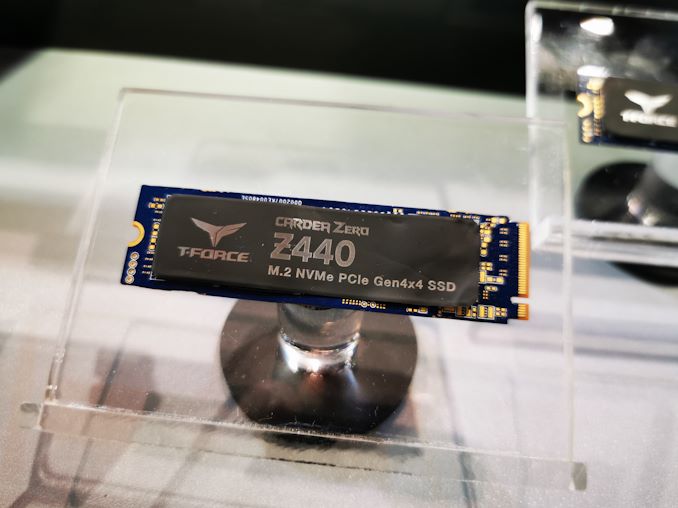

 Quote
Quote_575px.jpg)

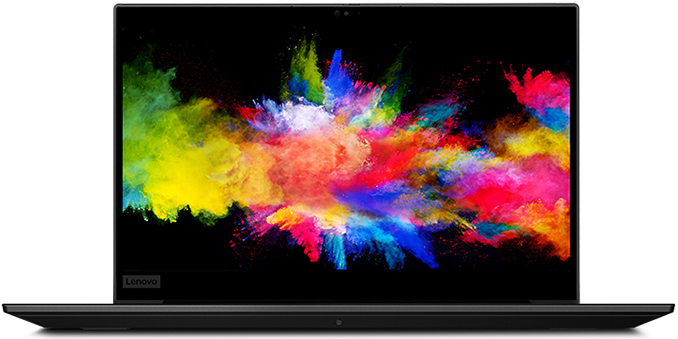
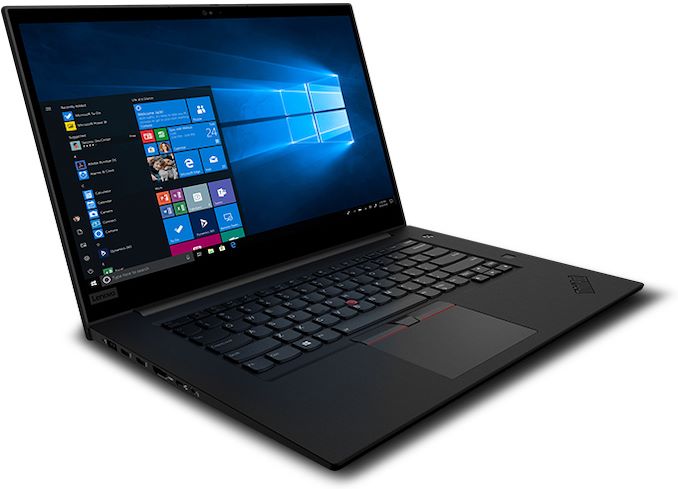
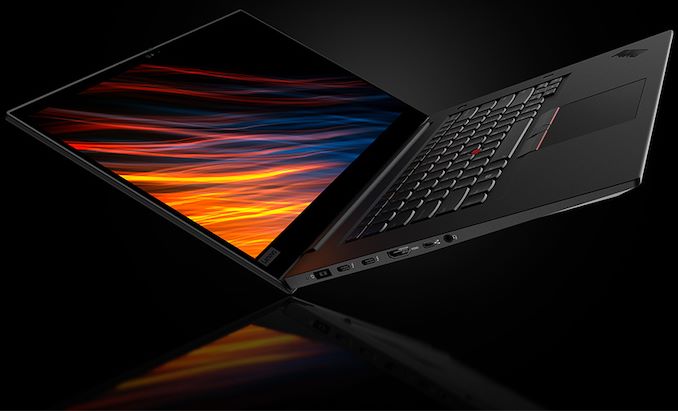
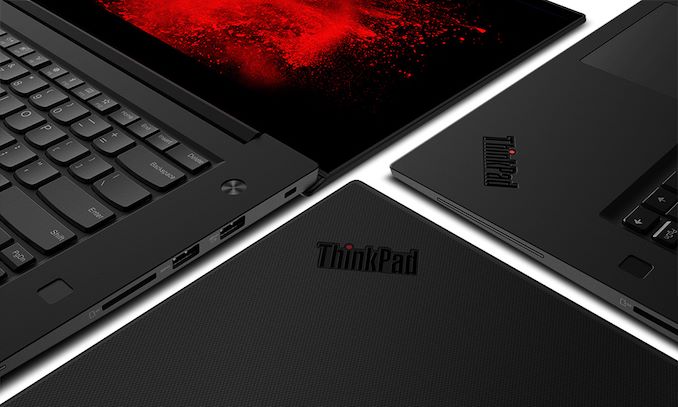

_575px.jpg)
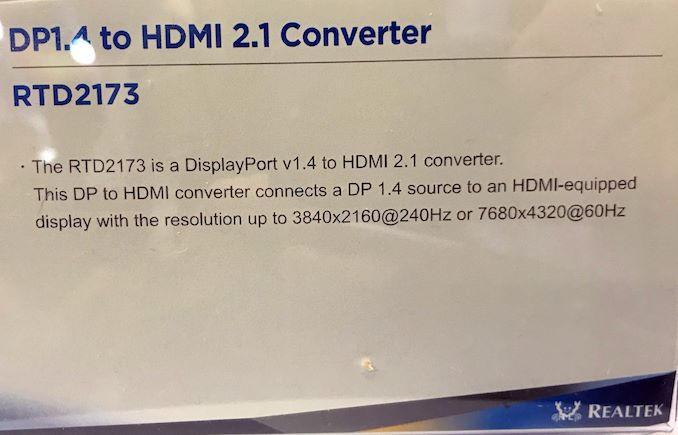
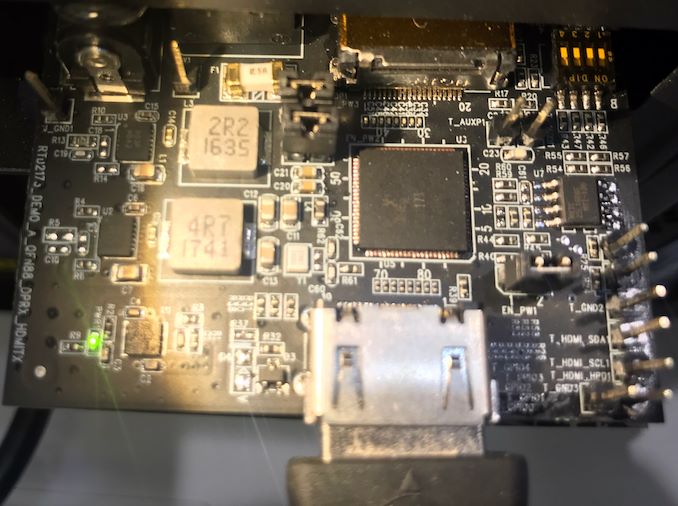
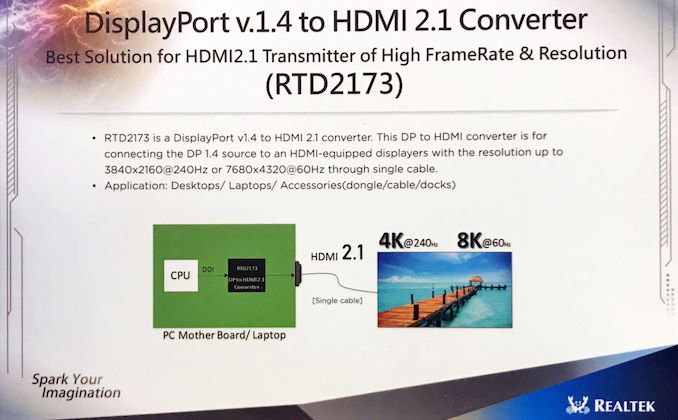
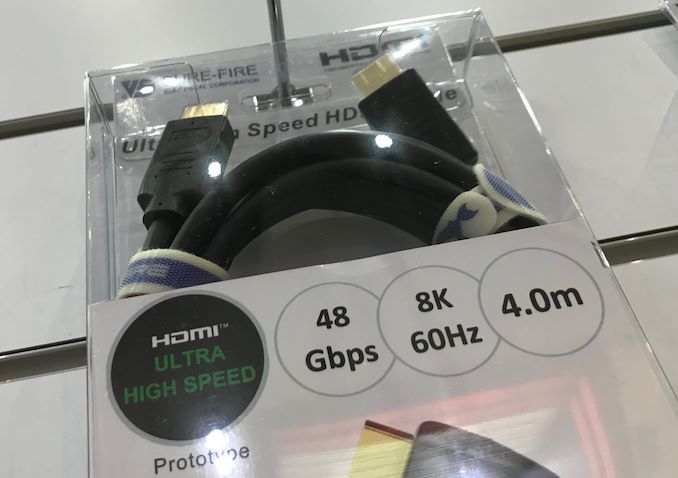
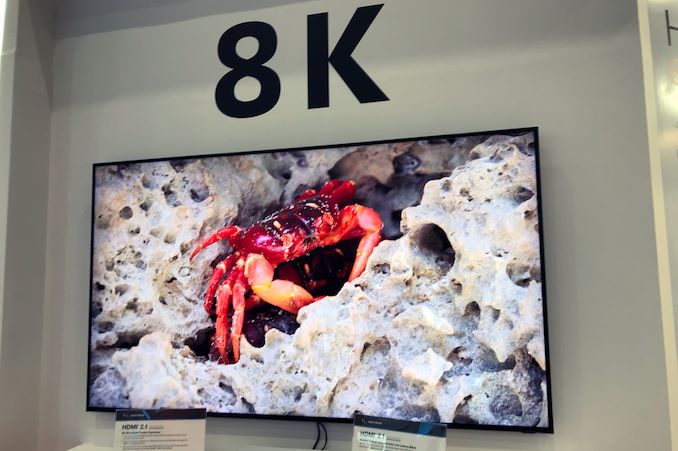

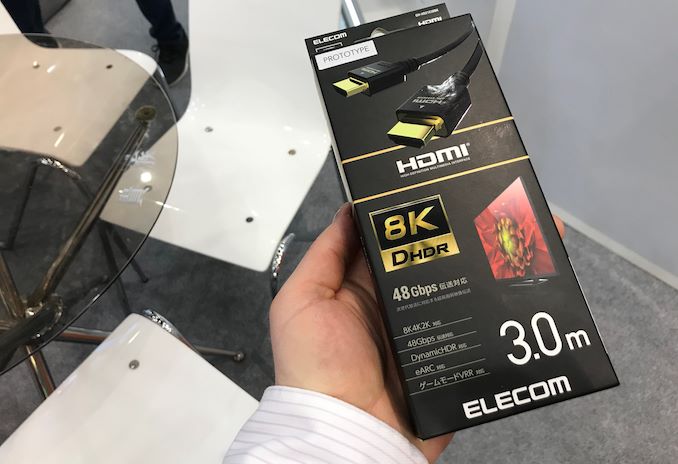
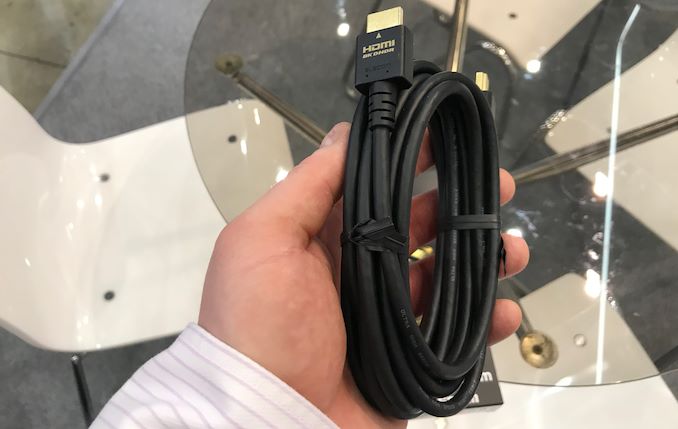

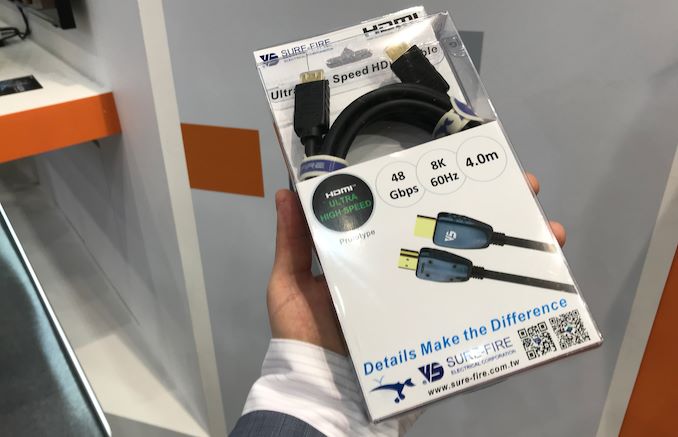
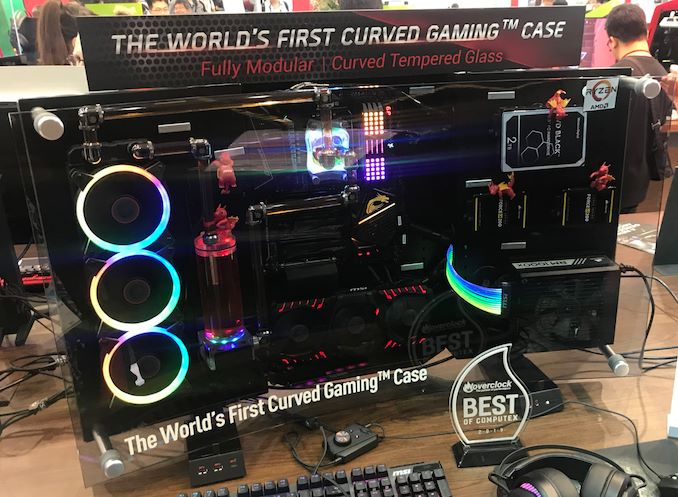
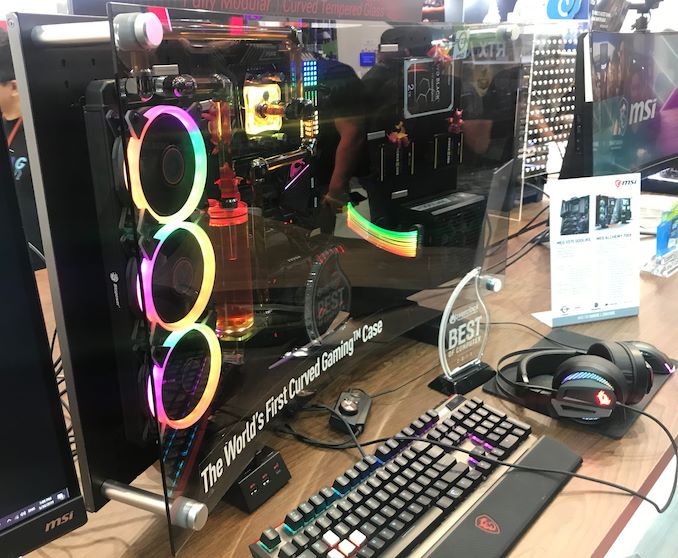
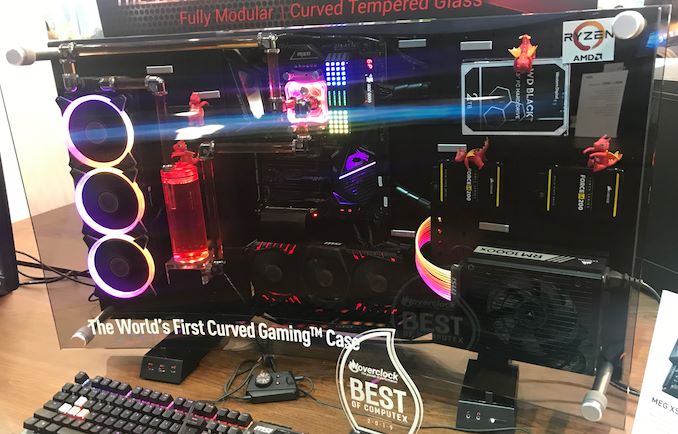
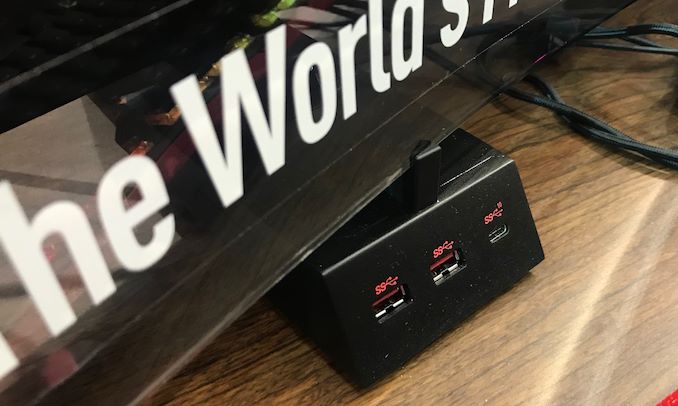
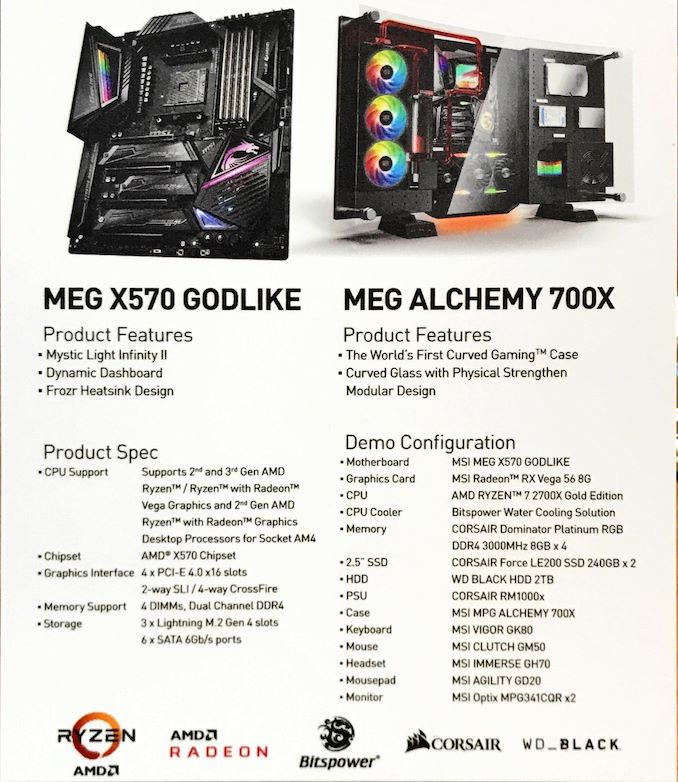
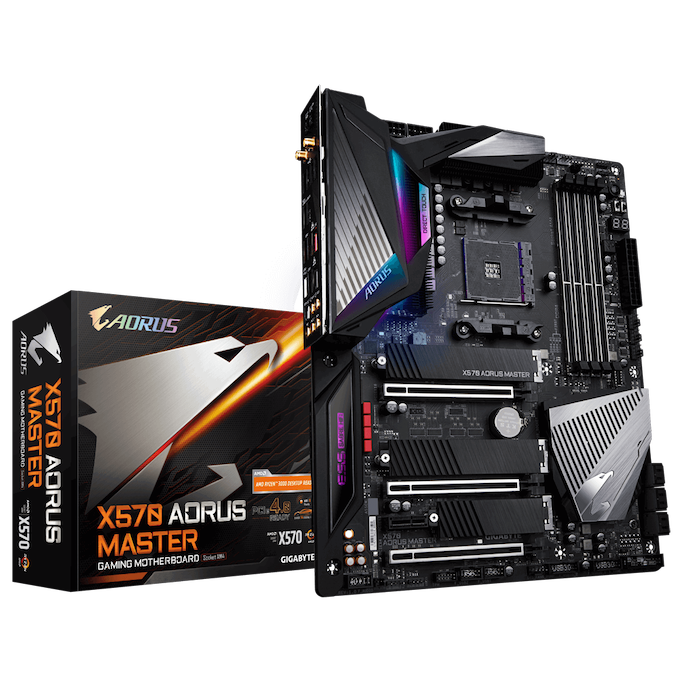
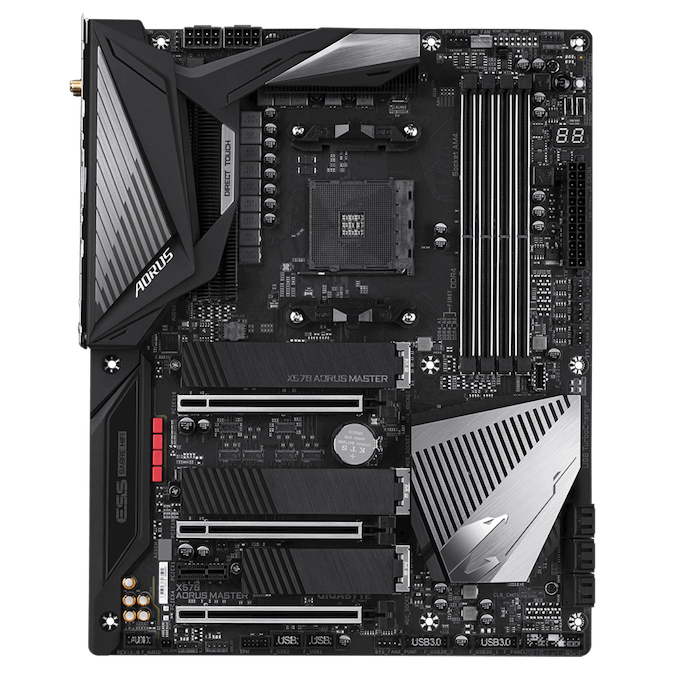

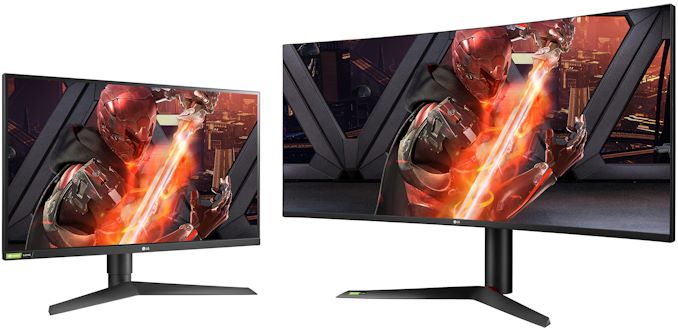
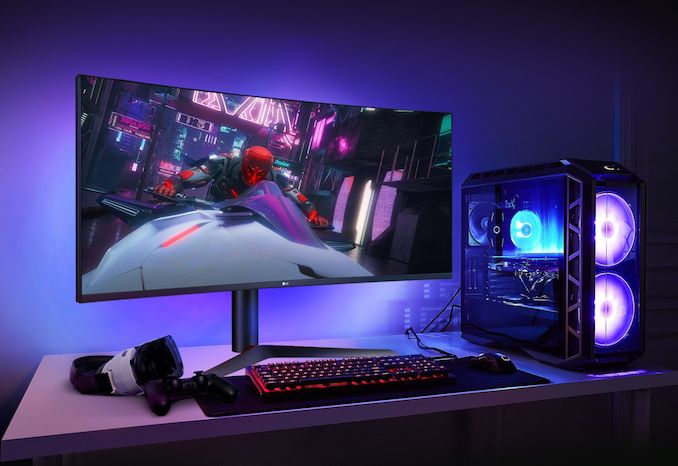
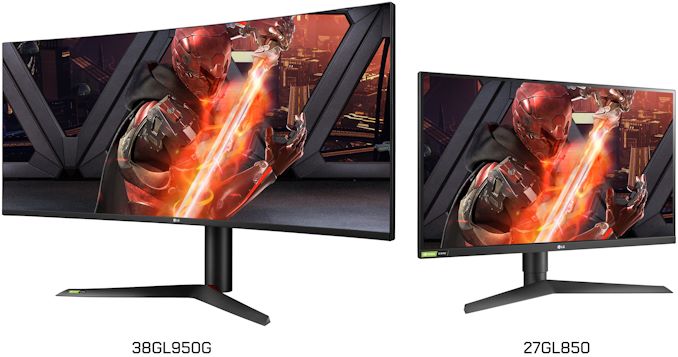
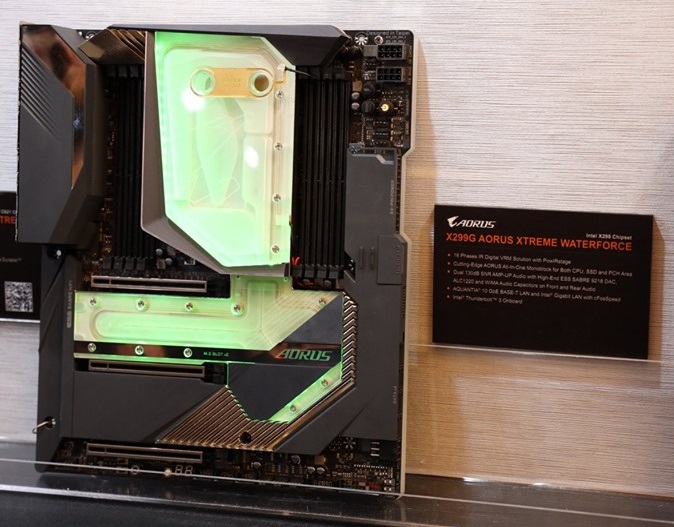

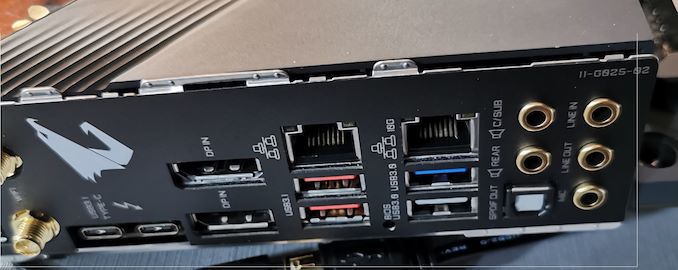
















Bookmarks